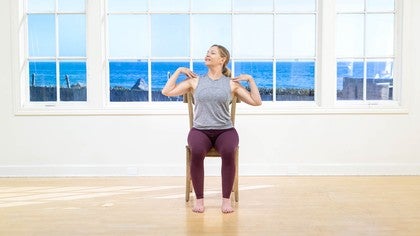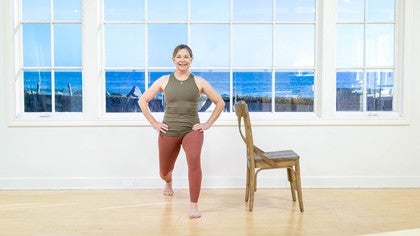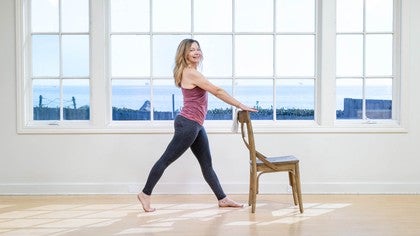Description
About This Video
Transcript
Read Full Transcript
Hi, my name is Amy Havens and I'm here with Pilates Anytime teaching my second class of four in this series. This class is called Neck and Shoulders Partners and Allies. All you're gonna need is a sitting chair and another hand towel. Be sure to consult your doctor before starting any new exercise regime. We're gonna go ahead and get started.
So let's take a quick review from class number one. If you didn't take class number one, you can always go back and do that. We talked a little bit about the relationships of the stability of the spine, the core muscles of the spine. Right now I wanna talk specifically in cervical position and cervical spine. Okay, so that's your neck spine.
And let's go ahead actually, everybody, and have a seat for this, because I'm gonna talk for a little bit. You can have your towel nearby. We're not gonna need it initially. But in today's world, wouldn't you know that most of us have a little bit of neck and shoulder tension? I think I have on occasion, if not often, and sometimes what I know I need is to stretch my neck and/or stretch my shoulders to feel some release.
But sometimes I'm not sure maybe people don't know what to do with their neck and shoulders. So what I'm offering here is a little bit of release work for the neck and how that might feed into some release of the shoulders, and then also some strengthening of the neck and strengthening of the shoulders. They're so related, the neck and shoulder complex or this area. I'm gonna give you an idea here, you play with this. If you just tap your sternum for just a second, your breastbone.
Now if I could go behind myself and tap that part of my back, right? That was that upper thoracic spine we talked about in class one. I'm gonna give you a visual image of like roots of a tree, let's say, and that's your neck and the roots of your neck kind of exist between your shoulder blades on your back. Okay? Sometimes visuals work. Sometimes they don't, but I'll invite you to think that.
So the base of the neck muscles right down between the shoulder blades, that's where a lot of the roots of things can start and get problematic, all right? Specifically with your neck, you could feel it there. Also in today's world, our heads are forward quite a bit, right? Looking at screens, looking at phones, looking at things, carrying shoulder purses on one shoulder and stuff. So your head and your neck are taking the brunt over and over.
By having that head forward, you're gonna feel some strain of the neck because the head is too far in front of your shoulders. Okay? So let's take a look at some basic neck releases positions and then gentle activation, Okay? So first movement I wanna teach you, everybody, is cervical flection. That's we're gonna put our fingertips here for this exercise. So cervical flection is really just nodding your head down.
You're just simply gonna bend your neck down, forward. Look down at the ground. For many of you, you're already gonna feel a stretch in the back of your neck. Just feel it, okay? You should be doing these every day, by the way, and then go ahead and center your head.
Now we're gonna lift the chin up and extend the neck. Think of... Yeah, extension is length, and a slight upper back curve in your neck. Just slight. Let's do each one again. So cervical flection and then cervical extension.
All right. Pretty easy. We'll activate in just a minute. Now lateral flection is sideways. You're just gonna bend the neck and just park that for a minute and feel what you feel. Most of us are gonna feel a pretty interesting sensation on the side of the neck.
Okay, and up and over to the other side, yeah. Right, that long side neck muscle. Let's do each side again. This is lateral flection. I wanna just invite everyone to be reminded it's good to work the muscles of the neck.
So right now we're doing releasing things, but in a moment we're gonna actually work the muscles in the neck. It's important to work them for strengthening. A lot of times our neck is tired because it's weak. Just saying. Okay, we're gonna cervical rotation.
Cervical rotation, you're looking to the side of the room. You're really looking to see something. You've turned your neck, you've used your muscles of your neck to turn. Okay, do each side twice. Now what do you notice about your neck?
Are you feeling icky about turning the neck? We wanna be able to turn, go ahead each side, turn with freedom, ease of motion in the neck. This is one of the most primary motions of our neck that we need to be able to do to look around our environment, to be able to see what's around us and not just have our head forward all the time. Okay, face your hands down and then I want you to take your nose, you don't have to touch it like I did, but I'm gonna have you make a little circular motion with your nose. I like to do a visual image of a big magic marker on my nose and I'm making a perfect circle.
Okay, you're gonna do the other way now. Try to be pretty accurate about that circle. Right, so these are just really, really, really gentle mobility releasy the things. Okay, but now let's activate a tiny bit. We need to interlace our hands.
I want you to put your hands behind your neck, okay? Right, actually it's behind your skull, not just your neck, behind the skull. Elbows are open just a little bit away from your head. They're not real wide. That might actually push your head even more forward.
What I want you to do is go back to class one in your mind and remind yourself, okay, that's where a cervical curve needs to stay integrated. Okay? Here we go, everybody. Sitting tall, gently, gently is the word, press your head back into your hands. And I want you to think about the front of your throat also, like you're drawing it back. So that's an activation of some deep muscles in your neck.
Take a breath in, release that a little bit and do that again. Exhale and press your head back. And almost like you're bringing the back of your skull higher. Let's do that one more time. Take a breath.
Exhale, head presses back. So remember I talked about the root of the neck is kind of between the shoulder blades there. See if you can sense a little bit of activation in the muscles, in your upper back. They're helpful to strengthen the neck. So that brings that head back on the spine where it belongs instead of having our head forward.
Okay. Release your hands. We're moving onto extension now of the neck. So it's that gentle lift of the chin to stretch the front of the neck up. I want you to gaze at the wall in front of you, maybe where it meets the ceiling. That's a good place to point your chin.
That's high enough. That's enough extension, I should say. Okay, then the activation, place one hand in front of your forehead, and gentle is the word, press your head into your hand. Okay, just feel what you feel. You should feel some activation in the side neck muscles here.
And again, I'm gonna remind you, don't be afraid of that. Let's work those necks. Let's have strong toned neck muscles. Okay, relax, lower the hand. We'll just do one more on the other side.
So lifting that neck. We're working cervical extension, the activation, press your hand on your forehead. Lightly press your head into your hand. Again, I'm gonna ask you to concentrate on the muscles between your shoulder blades. You should be feeling some muscles kind of, I would say, kicking in or turning on.
Sometimes you'll hear us say activating. All right, the root of the neck, right there between the shoulder blades. Good. Let's come on up, all right. Cervical or lateral flection. So leaning your head to one side.
We have two options. We could activate this side or we could activate this side. We're gonna do both. So I'm gonna take my hand here. Okay. So again, lightly pressing head onto hand.
You probably will feel this side of your neck. You might even feel all the way down into your waistline. Now switch hands, press your head up into your hand. So again, we're already getting strengthening work in the neck very simply. Center the head.
Lateral flection to the other side. So we did those gentle releases, now activation. Gently pressing your head against your hand. Feel what you feel. Pretty interesting, huh?
Okay, chiropractors sometimes give you these exercises. You won't need to go to one maybe if you do these for yourself. Press your head into your hand. Nothing wrong with chiropractic though. I love chiropractic. Okay, and then center your head.
We're gonna do rotation similarly. Turn and see, what do you see there? Same thing, everybody, you're gonna use your hands. I want you to put one hand by the temple part of your forehead. And same thing, try to press your head back into that hand.
Just a little. You're gonna trigger those necks. Okay, change hands, and then it's this hand pressing head into hand. Feeling your neck. Yeah, try to keep that head back over the shoulders, release and turn other direction.
And this hand starts right on your temple. Sitting as tall as you can, head presses to hand very gently and release. Front hand and press. Good, and release and come to the front. Okay, and now I'm gonna give you a couple additional movements for your neck here.
These are kind of funky looking. This is a chicken neck. Trust me. Head forward and back, okay? Because we do gesture forward, right?
Some of us are kind of stuck with head forward. So let's work on gliding the head forward and back. Sometimes just moving the neck in a new way will release some tension that you may have down into the shoulders. Okay? Most often we don't want to move the head forward because we're getting away from that posture, but gliding back and up is a healthy motion to have. One more.
The next one's fun, it's the Egyptian. Who can move their head side to side? This is a tough one. Right, takes some interesting strengths to move the head side to side on the very specific part of the upper spine. See if you can do a couple.
It's very small. We just did that with the head pressing the hand. Okay, now you can feel how you're activating inside of your muscles of your neck. Okay, another fun one is diagonals. Let's put our hands here.
So diagonals, this is real common in sports, looking up, looking down. Important to have your head agile. Everybody, look up to the top right corner of your room. Okay, really use the neck and look up and then turn and look down to the bottom corner of your room. I'm actually gonna reference this elbow here.
I'm gonna look at that elbow. Okay, feel what you feel in the back of your neck. Slowly go to turn up, look at the top corner. Feel that neck, and then slowly look down to the bottom corner. One more.
Let's go upright and down left. Oh, that feels so good. Center, now we'll up, left, down, right, here we go. Most of us have a preferred movement pattern of the neck. So it's really important to learn, I think, what your preference is or what your preferred motion is.
That might be where you have more tension. So doing the opposite motion, here's our last one, may really give you some release if you have that tension. Okay, and then everybody just come on down here. We're gonna lift and lower the shoulders a little bit. Now so much tension lives I think, in right here.
Wouldn't you agree? Kind of the side of the neck and the top of the shoulders. So one of them... I love this lateral position a lot. So let's go back to lateral flection and just be there for a moment or two.
Okay, so if that's enough for you, if you're feeling like, wow, that's a lot of stretch, don't go any farther. If you want a little more, this feels great, take the opposite arm out. You can experiment with where your hand is positioned up or down. Okay, and now I do want everyone to think about the role of the shoulder, we're kind of segwaying into some shoulder stuff, that the shoulder is more efficient, effective optimal position in a lowered position, not up. That's where some of that tension lives, right?
So let's see if we can get that low shoulder. How does that feel? Pretty good? Let's do the other side too. So here we go. Right, and then there's a wonderful little yummy bit coming next called sponging the shoulders. So again, you can explore that hand movement.
You can go up, down, you can close your fingers. There's lots of things you can play with here, but really the essential I want you to have your takeaway is take the shoulder and just stretch it down low. Ah, what do you feel? Yeah, should be pretty easy to have the sensation right in the central air of the side of the neck. All right, so everybody, center your head and now here we go.
It's sponging, so you get to squeeze with your hand, squeeze the top of your shoulder. Yeah, massage yourself, squeeze. So we're not only giving awareness to this part of our shoulders, we're about to use the towel for some shoulder strengthening, but I want you to get blood flow into these muscles. Okay, you're gonna tap your shoulders. You're gonna tap kind of all the way around the back of your arm, down the side of your back.
Again, you're bringing some blood flow and awareness into muscles we're gonna work. You can even tap into your chest a little bit. Let's do one more round of sponging. It should feel pretty good. Okay, and then of course the other side awaits.
So squeeze, squeeze, squeeze. You can squeeze pretty firm. These muscles need it. They need a lot of TLC, a lot of attention and release. Squeeze, like you're filling up water into the muscles. Yeah, okay.
And then tap, tap, tap, kind of more on the shoulder upper arm side of your back. (taps arms) Bringing awareness, bringing blood flow. One more round of squeezing. You can do your chest, I forgot. Tap, tap, tap, and then squeeze and sponge.
Okay, one more little preparation, but it's a really great awareness tool. If you have your... Get your fingertips, guys, and tap your sternum again. Right at the top of the sternum, we have this bone, this reference called the manubrium, okay? I want you to put one finger on it, and then the other hand is gonna walk across your collarbone all the way over to your underarm.
This is known as your pectoralis major muscle, big peck muscle. Broaden the peck. Okay? Your pectoral muscle. Do the other side. We wanna really have broad chest. That's all. You're not thrusting your ribs.
You're just thinking how broad your chest is. Okay? Keep wearing that broad chest and pick up your towel. So here we go. Now the towel work, how I've got this is my tea towel, I'm gonna have you fold it again here and you can do one more fold to make it skinny, and then just put your hands on the outside of the towel. So we're about to do some shoulder work.
You know, we'll be going from low to high in some of these ranges. Feel free to stay seated if you'd like to. I'm gonna stand up. I like to really feel the inclusion of this postural work with my shoulder work, and also how to stabilize the head on the shoulders and the neck position. Okay, so this is called taut towel, tauting the towel.
I want everybody to stand with your legs apart, hands on the outside of the towel, and simply with your broad chest, pull the towel a little bit. Not a whole lot happens, but you're gonna activate into your chest and upper arms and the root of your neck in your upper back. Right, and then just release. And then pull the towel and release. And pull the towel and release.
And then pull one more time and just hold that. Now I'm gonna use a visual of... Oh, what can I have? The sides of the neck right now. Lengthening up like kind of vines maybe out of the ground, up out of my shoulders.
So I'm not necessarily yanking my shoulders down. I wanna imagine my neck strong and long going up. Okay, try that on and see how that feels. Now let's add the taut towel work more in front of the chest. This could be a little challenging for some.
If it is and it doesn't feel good, never do something that doesn't feel good. You'll stay down here. Okay, but I'd love to see if we can go into a few different ranges here. So in front of the chest, with that bright broad chest, taut your towel and release. And taut your towel.
It's like you're trying to rip this towel in half, and release. Two more, and keep that cervical spine nice and organized right above your shoulders. If you're prone to being the chicken neck, bring that head back and then one more, taut the towel. Okay, stay with it. Hold the towel. Can you feel muscles working on the side of your shoulders, down your back, maybe in the root of your neck between your shoulder blades?
Probably so, and then down. Okay, one more position with your hands this way. And it's gonna be above the head, kind of on a diagonal. I'm not going all the way above my head. I'm on a little diagonal, four times.
Let's take a breath, exhale and taut the towel, and release. So this is the hardest position I think, to keep the neck organized and the tension out of the shoulders. So we lengthen the neck up out of the shoulders. Remember we're working with low shoulders. Last time, everyone, taut that towel and lower it down.
Okay, so that was with palms faced down. We're gonna do similar movement with palms face up, different, different angle of the upper arm in the shoulder. So everyone, just very gently broaden the chest. We'll do four down here, four here and four above. Let's take a breath.
Exhale and pull the towel taut. Hold and release. And pull the towel taut and release, keeping awareness of your head and your neck right on the shoulders and pull. And you can stay down low like that or come along here. Inhale and exhale. Pull the taut.
Take a look at your wrist and see how nice and flat your wrist is staying. It has a relationship to your neck, and pull and release one more here, or like I said, you can stay here or go with me all the way up. I'm on that diagonal. Take a breath. Okay, this is the most tricky position. Long neck, low shoulders, and taut the towel, hold and release.
Feel the muscles between the shoulder blades stabilizing the neck a little bit, supporting the neck. Outwardly rotate your upper arm bones, kind of peeling them away from your cheekbones. Last one. Good, everybody. Okay, let's give the shoulders a rest from that position.
Yeah, palms down again. Now I'm gonna take it into what I call chest poles. Raise the arms in front of your chest again. And we're trying to pull evenly both hands, but bending the elbows. Now let's just do the slowly ones.
If you can, see how my elbows are lifted, that may or may not feel okay for you. If that doesn't feel good, you'll know. You're gonna be wanting to be this person, angle your elbows down. Okay, I'll show a few this way and a few this way. But as we come from the chest and we're pulling, think of the broad chest.
I'm gonna do elbows down first, broad chest and release it front. And bend broad chest and release it front. Two more, broad chest and release it front. Okay. You can keep going there. I'm gonna do elbows up a little bit.
Broad chest, feel the muscles between the shoulder blades and the sides of your back. All those muscles strengthening to support this lovely long, strong neck. Last one, in and release it. Okay, how you doing? I'm gonna do some diagonals now.
Okay, so just kind of follow what I'm doing. I'm gonna start low and I'm kind of accentuating this straight arm pulling up and out to the side. The other elbow is bending, but I'm still trying to pull with both hands. Okay, keep that going. You can stay low like this or we'll go to the midline and it's gonna go across the body and across the body, and across and across.
How about diagonals, up like above the head a little bit where we took those arms initially. Okay, you're still pulling with both, moreso with the straight arm. All right, I want everybody to lower the arms just for a minute. We're about to do a pattern. Low, low, middle, middle, high, high, middle, middle.
We'll try three or four sets, ready? So it's kind of you just keep moving, and pull and pull, above, above, and middle and middle. Start down and side and up. Feel the strength work? Let's go two more sets. We've got this.
Down and down and side and side, and up and up and side and side. Your neck is strong and long. No tension, and up and up. And that is what we do with that, and lower here, guys. Good. Okay, we need to put the arms behind the body.
So for all of those shoulder exercises have been in this plane right in front of us. So we can do behind. I want you to take your hands on the towel. Put the towel behind your pelvis, your thighs, and broaden your chest. Okay, this is shoulder extension.
We just did shoulder flection. We're gonna press the arms behind the body and we're gonna do that with a nice low shoulder girdle and a long neck. And how far can you go back there? Hold that position and I want you to feel again, shoulders low. Alrighty, and then bring the towel back to your thighs.
So from the side view, I'm again, really trying to hold that postural awareness that we had in class number one. That strong, long spine. I'm gonna have it inhale prepare, exhale as we press back. I am trying to taut the towel. I want you to taut your towel, ready?
Press back and forth. Now you can stay there or narrow your hands a couple inches. It's more challenging. It's kind of fun to do that. Let's do four more, ready?
Exhale, press, taut the towel. Oh, new muscles. Roll the shoulders, open the chest and close. And two more, press the arms back and close. Last one, guys, press and hold.
We're gonna pulse. Pulse the arms up a little higher just going up and up. Just eight of these, up and up. Taut the towel, four. Where's your neck? Where are your shoulders?
And that is all we need to do, but hold onto it. We have the zigzags. Bend one elbow, pull the other. Open that broad chest, slowly swing and do the other side. And so we're not going higher than this, right?
This is a complicated exercise. Really nice to strengthen the shoulder, the rotator cuff group. Again, all the structure in between the shoulder blades. Okay. Keep your neck long. Coming up out of the shoulders.
I'm just gonna do four more. One and two and three and four. All right, and relax. Now, one more in front of the body. Take your hands wide, as wide as you can on your towel.
Stand comfortably. I'd love to do a full range arc, is what I call it, from down to above the head. So a moment ago we took it on a diagonal. We're gonna see if we can keep going higher right above the crown of the head. Keeping really sound alignment with the head, neck and shoulders.
Okay, four times. Let's see what we have. Nice and slow, and please only go as high as your shoulders let you go. You'll know. If it feels icky, you just don't go there. Right? But as your arms are coming higher, what if it's also saying to your spine, "Hey, spine, come up higher," right? The neck is long, shoulders are low.
And then lower all the way down. So by working the shoulders, strengthening the shoulders, you see, are you feeling a little extra release in your neck? I hope so. And lower, we've got two more of these and then a wonderful exercise with the chair. (Amy exhales) Staying nice and tall, root it down into the feet.
And one more here, everybody. Lift, lift, lift, and lower. Okay, we're doing so great. We're gonna enjoy a wonderful stretch with the chair. So you can just put your towel down on the chair.
We're gonna turn the chair sideways. Okay, and this you can do at the kitchen sink also, if you ever wanted to do an extra place in your house. I want you to put the hands on top of the chair and your palms and press down a little bit. And you're gonna feel that connections continue down into the side of the arm. I want everybody to step back pretty far away from the chair with your feet apart, you can bend your knees.
In fact, it feels really nice to bend the knees. Now let's study this position for quite a while, right? So I would love, I'd love to be able to have your head right between your arms, not below your arms. That's that chicken neck we're getting away from. Not above.
Can you go right between? Basically we just were there in that towel exercise. Okay, now concentrate on the muscles right between your shoulder blades. They're holding the neck. Kind of feel that they're holding the neck.
Press your hands on the chair. Take several deep breaths, everybody, long and strong, strength with length. Take some deep breaths through the nose. Use that exhale, pull those abdominal muscles to your spine. Three more breath cycles, in and out.
(Amy exhales) Two more in and out. Keeping that head centered between your arms. And one more in and out breath here. (Amy exhales) Now to start coming up I want you to round your low back a little bit. Start to kind of make a stretch dropping your tailbone underneath.
You're not gonna do a huge motion, start to broaden your chest or your shoulder blades and walk your feet forward into your chair. You've had your head slightly below head level, or heart level. So just take your time to get up. One more exercise. I love to finish with some extension. Okay?
I like to put the hands just here on the chair. You can hold with elbows bent, get close. Now remember how we looked forward and we looked at the wall and the ceiling? You're gonna do that again and guide it with your manubrium. See how that comes back.
Aim that manubrium right for this wall and the ceiling. And I just want you to hold, concentrate on the muscles between your shoulder blades, how easy your neck is, how lifted and strong your upper back and shoulders are. Take three more deep breaths, everybody. (Amy exhales) Keep that pelvis right against your chair. Two more breaths.
Lifting, opening, sides of the neck are long. Your head is supported. And recenter your head. Oh, how do you feel? I hope you all feel really, really good.
I know that I do. Thank you so much for joining me today for class number two.
Empowered Aging: Active Aging with Amy Havens
Comments
You need to be a subscriber to post a comment.
Please Log In or Create an Account to start your free trial.


























